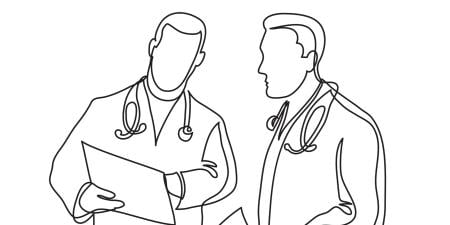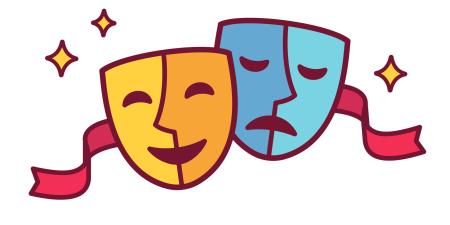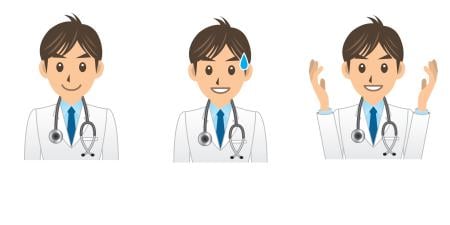My pager went off. It was 1:30 AM. My next admission as night float resident was a renal transplant patient with a bump in her creatinine, hyperkalemia, and hypoglycemia. After a detailed interview about her current and recent medications, I learned that she had discontinued an oral hypoglycemic about 3 days ago, and the combination of a slow half-life and renal failure was extending its effect. The attending physician I was assigned to that month was the associate chief of medicine and happened to be her primary care nephrologist, so I called him with the case. We talked for a few minutes, agreed on a plan, and I went back to work. This case would not have been particularly memorable, were it not for the surprise I got at 2:30 AM. My attending arrived. He had driven in from his suburban home to see one of his primary care patients, even though she was medically stable.
It was from this and many other experiences over the years that I learned professional values—a process that continues long after my medical school and residency years have passed. And while I firmly believe that professionalism can be learned, I'm often asked about whether or not it can be taught. Teaching and learning are 2 entirely different processes. The brightest teacher can teach a course using the best pedagogical skill, and students can still fail to learn. We don't think too much about this in the world of teaching medical knowledge and skills, but when teaching professionalism, it becomes critical.
When asked, "How did you learn to act like a doctor?" most physicians will not think back to some lecture they had on professional values. Instead, they talk, as I did above, about role models and mentors—of residents and faculty and peers and patients who taught them something about what it means to be a physician. The problem, of course, is that those individuals who are seen as mentors may not realize they are mentoring, and those not seen as mentors may believe that they are always teaching professional values. Teaching and learning are very different propositions.
An example: with my usual entourage of residents and medical students on rounds, we dutifully file into the patients room, I interview the patient, then wash my hands before the examination. What do students learn from my example of washing my hands? Is he afraid of catching some disease? Is he worried about the infection control nurse who monitors our team on random occasions? Is he worried about bringing those hospital germs home to his family? Or, does he wash his hands because it is a sign of respect for the patient? As a teacher, if my only action is role modeling, without explanation, I have no idea which of these lessons I have taught.
Also important to note is that these "role-modeling" events don't happen at specified times in the curriculum. There is good evidence that professional values are taught primarily late at night, during on-call periods—in the interstices of the curriculum: in the hallways, elevators, cafeterias, and conference rooms of the hospital. These are the places where professional values (both positive and negative) are forcefully taught—and learned by medical students.1
The hidden curriculum was first identified in the late 1960s by Philip Jackson observing teachers in elementary school classrooms. He found that the "hidden curriculum can also be represented as the three R's, but not the familiar ones of reading, 'riting, and 'rithmetic. It is, instead, the rules, regulations, and routines, of things teachers and students must learn if they are to make their way with minimum pain in the social institution called the school."2 Medical students learn professional behaviors by observing and imitating peers, residents, and faculty in the hallways, the cafeteria, and the elevator. Not just during lectures, but late at night, on-call in the hospital. The values of the profession may be idealized in lectures, but they are demonstrated and reinforced in the real-life setting of the hospital.
At 2:30 AM, when I was a night float resident, I learned what it meant to be a primary care physician. That lesson has directly affected how I have cared for hundreds of patients over the years. Was this something that my attending had consciously planned to teach? What would I have learned had he not made his middle-of-the-night trek?
Imagine yourself as a faculty member for a moment, actively trying to teach in the hidden curriculum. Of course, then it wouldn't be so hidden. But that, I believe, is the key to teaching professionalism: attending physicians must be consciously aware of the teaching that they do in the hidden curriculum. They must do this in such a way that they actively engage students and thus increase the concordance of teaching and learning. Role modeling alone is insufficient—since, as with my hand washing, there is no way to know what students are actually learning. Imagine what might happen if I walked out of the patient's room, and then asked my students why I washed my hands. The ensuing discussion might bring up a number of rationales, and I could guide the discussion in such a way as to ensure that my intended role modeling was pulled from the hidden to the explicit curriculum. While attending physicians routinely talk about the differential diagnosis of dyspnea, or the anatomy of the brachial plexus, we rarely open the discussion to why we took a patient's pulse when the nurse just did it 10 minutes ago (to establish rapport and start the examination in a nonthreatening way), or why we wear white coats (as a reflection of respect and a physical representation of our professional code).
Professionalism can, indeed, be taught. It has been for centuries. But not in the classroom, and not by role modeling alone. Professionalism can be taught in the hidden curriculum by encouraging and allowing faculty, residents, and medical students to have conversations about real-life events that challenge ideas of what it means to be a doctor. This need not be a lecture on responsibility to patients as a fundamental principle of professionalism; rather, just one faculty member demonstrating his professional commitment to patients, or one group of students and residents talking about behaviors of an attending or colleague they think demonstrated a lapse in professional behavior. The negative role models may be even more potent than the positive ones. It is as much a challenge for students to recognize these negative role models and learn from their mistakes as it is to find positive role models and emulate their behaviors. The greatest challenge for students today is to make the transition from passive to active learners—to recognize events that reflect professional behavior, to talk with others about them, and to then become their own teachers of professionalism.
References
- Stern D. Practicing what we preach? An analysis of the curriculum of values in medical education. Am J Med. 1998;104(6):569-575.
-
Jackson, P. Life in Classrooms. New York: Holt, Rinehart, and Winston; 1968:353.



